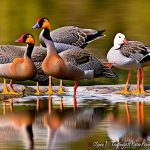Canadian Geese are a common sight in many parts of North America, including Oregon. These large waterfowl are known for their distinctive honking calls and V-shaped flight formations. While they may be a beautiful and iconic species, they can also be a nuisance, especially when they congregate on school fields in Oregon.
The problem with Canadian Geese on school fields is that they can cause significant damage to the turf and pose health risks to students and staff. Their droppings can cover the grass, making it unsightly and unsanitary. Additionally, their aggressive behavior during nesting season can pose a threat to anyone who comes too close.
Key Takeaways
- Canadian geese are a common sight in Oregon and can cause damage to school fields.
- Physical deterrents such as netting and fencing can be effective in keeping geese away.
- Visual scare tactics like decoys and lasers can also deter geese from school grounds.
- Sound-based repellents like sirens and bird distress calls can be used to keep geese at bay.
- Taste-based repellents like grape concentrate can discourage geese from feeding on school fields.
Understanding the Impact of Canadian Geese on School Fields in Oregon
Canadian Geese can cause extensive damage to school fields. Their constant grazing can wear down the grass, creating bare patches and uneven surfaces. This not only affects the aesthetics of the field but also makes it difficult for students to play sports or engage in other outdoor activities.
Furthermore, the droppings left behind by Canadian Geese can be a health hazard. Their feces contain bacteria and parasites that can contaminate the soil and water sources. This poses a risk of infection for anyone who comes into contact with the contaminated areas.
Physical Deterrents for Keeping Canadian Geese Away
One way to deter Canadian Geese from school fields is by implementing physical barriers. These barriers can prevent geese from accessing the area and causing damage. Some examples of physical barriers include fences, netting, and hedges.
Fences are a popular option for keeping geese out of school fields. They can be made from various materials such as chain-link or electric wire. Fences should be at least 3 feet high to prevent geese from flying over them. However, it’s important to note that fences may not be effective if geese have already established a presence on the field.
Netting is another option for keeping geese away. It can be installed over the field to create a physical barrier. However, netting may not be suitable for all situations, as it can be difficult to install and maintain.
Hedges can also be used as a physical deterrent. They create a natural barrier that geese are less likely to cross. However, hedges require regular maintenance to ensure they remain effective.
Implementing Visual Scare Tactics to Deter Canadian Geese
Visual scare tactics can be an effective way to deter Canadian Geese from school fields. These tactics work by creating the illusion of a predator or danger, which scares the geese away. Some examples of visual scare tactics include decoy predators, reflective tape, and scarecrows.
Decoy predators, such as plastic owls or coyotes, can be placed on the field to deter geese. The presence of these predators signals danger to the geese and encourages them to find a safer location.
Reflective tape can also be used as a visual deterrent. When hung around the field, the tape reflects light and creates a sense of movement, which scares geese away.
Scarecrows are another option for visual scare tactics. These human-like figures can be placed on the field to create the illusion of a person. Geese are naturally wary of humans and will avoid areas where they perceive a potential threat.
Utilizing Sound-based Repellents to Keep Canadian Geese at Bay
Sound-based repellents can be an effective way to deter Canadian Geese from school fields. These repellents work by emitting loud noises or distress calls that mimic the sounds of predators or danger. Some examples of sound-based repellents include propane cannons, ultrasonic devices, and recorded distress calls.
Propane cannons produce loud bangs that mimic the sound of gunshots. The sudden noise startles geese and encourages them to leave the area. However, it’s important to use propane cannons responsibly and consider the impact on nearby residents.
Ultrasonic devices emit high-frequency sounds that are unpleasant to geese but inaudible to humans. These devices can be placed around the field to create a deterrent zone. However, it’s important to note that ultrasonic devices may not be effective if geese have become accustomed to the sound.
Recorded distress calls can also be used to deter geese. These calls mimic the sounds of injured or distressed geese, which signals danger to other geese and encourages them to leave the area.
Using Taste-based Repellents to Discourage Canadian Geese from School Fields

Taste-based repellents can be an effective way to discourage Canadian Geese from school fields. These repellents work by making the grass or other vegetation on the field taste unpleasant to geese. Some examples of taste-based repellents include chemical sprays, garlic-based solutions, and hot pepper sprays.
Chemical sprays can be applied to the grass or other vegetation on the field. These sprays contain substances that make the grass taste bad to geese. However, it’s important to use these sprays responsibly and follow the manufacturer’s instructions.
Garlic-based solutions can also be used as a taste-based repellent. These solutions can be sprayed onto the grass or other vegetation to create an unpleasant taste for geese. However, it’s important to note that garlic-based solutions may need to be reapplied regularly for them to remain effective.
Hot pepper sprays can also be used as a taste-based repellent. These sprays contain capsaicin, the compound that gives peppers their heat. When sprayed onto the grass or other vegetation, hot pepper sprays create a burning sensation in geese’s mouths, discouraging them from feeding.
Creating Barriers and Fencing to Prevent Canadian Geese from Accessing School Grounds
Creating barriers and fencing can be an effective way to prevent Canadian Geese from accessing school grounds. These physical barriers create a boundary that geese are less likely to cross. Some examples of effective barriers and fencing options include electric fences, floating barriers, and goose-proof fencing.
Electric fences can be installed around the perimeter of the school grounds to create a barrier that geese are reluctant to cross. These fences deliver a mild electric shock when touched, which deters geese from attempting to enter the area.
Floating barriers can be placed in bodies of water near the school grounds to prevent geese from accessing the area. These barriers create a physical barrier that geese are unable to swim or fly over.
Goose-proof fencing is specifically designed to prevent geese from entering an area. These fences are typically taller than standard fences and have angled tops that make it difficult for geese to perch or fly over.
Implementing Habitat Modification to Make School Fields Less Appealing to Canadian Geese
Habitat modification can be an effective long-term solution for making school fields less appealing to Canadian Geese. This involves altering the environment in ways that discourage geese from nesting or feeding on the field. Some examples of effective habitat modification techniques include reducing water sources, removing nesting sites, and planting unpalatable vegetation.
Reducing water sources can help discourage geese from congregating on school fields. This can be done by fixing any leaks or drainage issues that create standing water. Additionally, installing motion-activated sprinklers can deter geese from accessing water sources.
Removing nesting sites can also help discourage geese from nesting on school fields. This can involve removing tall grasses or shrubs where geese may build their nests. Additionally, installing nest deterrents, such as spikes or netting, can prevent geese from nesting in certain areas.
Planting unpalatable vegetation can make school fields less appealing to geese. This can involve planting grasses or other plants that geese find less desirable. Additionally, using native plants that are adapted to the local climate can help create a less attractive habitat for geese.
Educating the Community on Coexisting with Canadian Geese in Oregon
Educating the community on coexisting with Canadian Geese is an important aspect of managing their presence on school fields in Oregon. Many people may not be aware of the damage and health risks associated with geese or how to effectively deter them. By providing information and resources, the community can better understand the importance of taking action and implementing deterrent measures.
Tips for coexisting with Canadian Geese include:
1. Avoid feeding geese: Feeding geese can encourage them to stay in an area and can lead to overpopulation.
2. Keep a safe distance: It’s important to keep a safe distance from geese, especially during nesting season when they can become aggressive.
3. Clean up after geese: If geese have left droppings on school fields or other areas, it’s important to clean up the mess promptly to prevent the spread of bacteria and parasites.
4. Encourage natural predators: Encouraging natural predators, such as foxes or coyotes, can help keep geese populations in check.
Implementing a Comprehensive Management Plan for Long-term Canadian Geese Control
Implementing a comprehensive management plan is necessary for long-term Canadian Geese control on school fields in Oregon. This involves taking a multi-faceted approach that combines various deterrent methods and strategies. A comprehensive plan should include:
1. Assessing the situation: Before implementing any deterrent measures, it’s important to assess the extent of the problem and identify specific areas where geese are causing damage or posing health risks.
2. Choosing appropriate deterrent methods: Based on the assessment, choose the most appropriate deterrent methods for the specific situation. This may involve a combination of physical barriers, visual scare tactics, sound-based repellents, taste-based repellents, barriers and fencing, and habitat modification.
3. Implementing deterrent measures: Once the appropriate deterrent methods have been chosen, it’s important to implement them effectively. This may involve hiring professionals or trained personnel to install and maintain physical barriers, scare devices, or other deterrent measures.
4. Monitoring and adjusting: It’s important to regularly monitor the effectiveness of the deterrent measures and make adjustments as needed. This may involve changing the placement of scare devices, reapplying taste-based repellents, or modifying habitat modification techniques.
5. Educating the community: As mentioned earlier, educating the community on coexisting with Canadian Geese is an important aspect of long-term management. This can involve distributing educational materials, hosting workshops or presentations, or providing resources for further information.
In conclusion, Canadian Geese can be a problem on school fields in Oregon due to the damage they cause and the health risks associated with their presence. However, there are various methods for deterring geese and preventing them from accessing school grounds. These methods include physical barriers, visual scare tactics, sound-based repellents, taste-based repellents, barriers and fencing, habitat modification, and community education. By implementing a comprehensive management plan that combines these methods, schools in Oregon can effectively control Canadian Geese populations and prevent damage and health risks associated with their presence on school fields.
If you’re looking for effective methods to keep Canadian geese away from school fields in Oregon, you might find this article on Poultry Wizard helpful. It provides valuable insights on how to care for goslings, which can be useful in understanding the behavior of geese and implementing strategies to deter them. Check out the article here for expert advice on goose care and management.
FAQs
What are Canadian geese?
Canadian geese are a species of waterfowl that are native to North America. They are known for their distinctive black heads and necks, white cheeks, and brown bodies.
Why are Canadian geese a problem on school fields in Oregon?
Canadian geese can cause damage to school fields by leaving behind large amounts of droppings, which can be unsightly and unsanitary. They can also be aggressive towards people, especially during nesting season.
What are some methods to keep Canadian geese away from school fields?
Some methods to keep Canadian geese away from school fields include using decoys, installing fencing or netting, using noise deterrents, and modifying the landscape to make it less attractive to geese.
Are there any humane methods to keep Canadian geese away from school fields?
Yes, there are humane methods to keep Canadian geese away from school fields. These include using visual deterrents, such as reflective tape or balloons, and using natural deterrents, such as planting tall grasses or shrubs that geese do not like.
Is it legal to harm or kill Canadian geese?
No, it is not legal to harm or kill Canadian geese without a permit from the U.S. Fish and Wildlife Service. Canadian geese are protected under the Migratory Bird Treaty Act.
Meet Walter, the feathered-friend fanatic of Florida! Nestled in the sunshine state, Walter struts through life with his feathered companions, clucking his way to happiness. With a coop that’s fancier than a five-star hotel, he’s the Don Juan of the chicken world. When he’s not teaching his hens to do the cha-cha, you’ll find him in a heated debate with his prized rooster, Sir Clucks-a-Lot. Walter’s poultry passion is no yolk; he’s the sunny-side-up guy you never knew you needed in your flock of friends!







